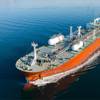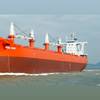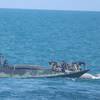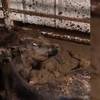Nearly a year after the Kursk submarine sank in the Barents Sea with the loss of all on board, Russia packed 99 journalists onto a ship and took them to the site of the catastrophe. The Kremlin says it wants to make the lifting of the 18,000 ton nuclear-powered warship a model of multi-media openness, after weathering fierce criticism last summer for its handling of an accident that is still shrouded in mystery.
Horror at the loss of one of Russia's most modern submarines and her 118 crew last August quickly turned to popular outrage.
President Vladimir Putin failed to cut short a Black Sea holiday to oversee rescue efforts, which were hampered by the navy's reluctance to accept offers of help from abroad. Journalists, apart from state television, were kept away, and much of the information in officials' reports later proved to have been overly optimistic or completely false. Igor Botnikov, a senior Kremlin press department official, said Russia was determined not to repeat last year's mistakes.
"It is fair to say we learned a lot from what we did poorly last year," Botnikov said on board the ship Klavdia Yelanskaya which chugged out of Murmansk with its 99 reporters, photographers and television cameramen on Monday evening. "So we have invited the world's journalists to see what's going on here in the Barents Sea, to show we have nothing to hide with this operation."
Last August the navy's top brass took two days to first reveal "malfunctions" on board the OSCAR II class Kursk. Then they delivered a rash of contradictory messages. There was talk of a collision with a foreign vessel in the Arctic waters. The crew was said to be alive inside the submarine, first in radio contact and later tapping distress signals on the hull. Then officials then announced that the entire crew had died within minutes of unexplained explosions on board.
Finally, a note was found on one of the dozen bodies brought to the surface last autumn, proving that at least some crew members had lived for hours, if not days. Russia now says exploding torpedoes on board sank the Kursk, although it does not say what caused the torpedoes to detonate. A government commission says it hopes raising the Kursk will give it the vital clues it needs.
But foreign military experts think the Kursk and its disastrous end holds far too many military secrets for there ever to be a really open inquiry. They say the Kursk was probably fitted with highly advanced torpedoes of which neither European nor U.S. military chiefs have details. It may also have had a state-of-the-art sonar system never seen outside top secret Russian naval bases. Many saw a desire for secrecy at the heart of the navy's delay in allowing foreign rescue teams to try and enter the stricken Kursk.
This year as last, only Russian divers will actually work on the Kursk -- their Norwegian, Dutch and British colleagues are expected to stay inside diving bells which will lower them the 100 meters (330 feet) to the craft. Botnikov said Russia had security issues to consider, as would any country.
"It's a case of finding the golden mean," he said. "Finding a line between what is fine to show everyone and what, naturally, we should be wary of revealing to the world." - (Reuters)
Featured videos

Unlock Onboard Data Efficiencies

Tracking Foreign Vessels Working in the U.S. Jones Act Market

Inmarsat Enhances Service to Drive Digitalization
Subscribe for
Maritime Reporter E-News
Maritime Reporter E-News is the maritime industry's largest circulation and most authoritative ENews Service, delivered to your Email five times per week









